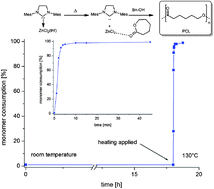Protected N-heterocyclic carbenes as latent pre-catalysts for the polymerization of ε-caprolactone†
Abstract
Various protected

* Corresponding authors
a
Institute of Polymer Chemistry, University of Stuttgart, Pfaffenwaldring 55, D-70569 Stuttgart, Germany
E-mail:
michael.buchmeiser@ipoc.uni-stuttgart.de
b Evonik Industries, Paul-Baumann-Straße 1, D-45764 Marl, Germany
c Institute of Organic Chemistry, University of Stuttgart, Pfaffenwaldring 55, D-70569 Stuttgart, Germany
d Institute of Textile Chemistry and Chemical Fibers, Körschtalstr. 26, D-73770 Denkendorf, Germany
Various protected

 Please wait while we load your content...
Something went wrong. Try again?
Please wait while we load your content...
Something went wrong. Try again?
S. Naumann, F. G. Schmidt, W. Frey and M. R. Buchmeiser, Polym. Chem., 2013, 4, 4172 DOI: 10.1039/C3PY00548H
To request permission to reproduce material from this article, please go to the Copyright Clearance Center request page.
If you are an author contributing to an RSC publication, you do not need to request permission provided correct acknowledgement is given.
If you are the author of this article, you do not need to request permission to reproduce figures and diagrams provided correct acknowledgement is given. If you want to reproduce the whole article in a third-party publication (excluding your thesis/dissertation for which permission is not required) please go to the Copyright Clearance Center request page.
Read more about how to correctly acknowledge RSC content.
 Fetching data from CrossRef.
Fetching data from CrossRef.
This may take some time to load.
Loading related content
